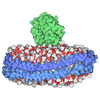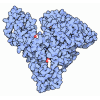+ Open data
Open data
- Basic information
Basic information
| Entry | Database: PDB / ID: 8grx | ||||||
|---|---|---|---|---|---|---|---|
| Title | APOE4 receptor in complex with APOE4 NTD | ||||||
 Components Components |
| ||||||
 Keywords Keywords | IMMUNE SYSTEM / Receptor complex | ||||||
| Function / homology |  Function and homology information Function and homology informationinhibitory MHC class I receptor activity / immune response-regulating signaling pathway / lipid transport involved in lipid storage / intermediate-density lipoprotein particle clearance / positive regulation of lipid transport across blood-brain barrier / regulation of cellular response to very-low-density lipoprotein particle stimulus / metal chelating activity / triglyceride-rich lipoprotein particle clearance / discoidal high-density lipoprotein particle / lipoprotein particle ...inhibitory MHC class I receptor activity / immune response-regulating signaling pathway / lipid transport involved in lipid storage / intermediate-density lipoprotein particle clearance / positive regulation of lipid transport across blood-brain barrier / regulation of cellular response to very-low-density lipoprotein particle stimulus / metal chelating activity / triglyceride-rich lipoprotein particle clearance / discoidal high-density lipoprotein particle / lipoprotein particle / negative regulation of triglyceride metabolic process / maintenance of location in cell / regulation of amyloid-beta clearance / negative regulation of cholesterol biosynthetic process / positive regulation of lipoprotein transport / Transcriptional regulation by the AP-2 (TFAP2) family of transcription factors / chylomicron remnant clearance / chylomicron remnant / intermediate-density lipoprotein particle / acylglycerol homeostasis / NMDA glutamate receptor clustering / very-low-density lipoprotein particle remodeling / Chylomicron clearance / phosphatidylcholine-sterol O-acyltransferase activator activity / positive regulation of phospholipid efflux / Chylomicron remodeling / lipid transporter activity / positive regulation of low-density lipoprotein particle receptor catabolic process / cellular response to lipoprotein particle stimulus / very-low-density lipoprotein particle clearance / Chylomicron assembly / response to caloric restriction / high-density lipoprotein particle clearance / phospholipid efflux / chylomicron / regulation of protein metabolic process / very-low-density lipoprotein particle receptor binding / regulation of amyloid fibril formation / lipoprotein catabolic process / AMPA glutamate receptor clustering / high-density lipoprotein particle remodeling / melanosome organization / positive regulation of cholesterol metabolic process / regulation of behavioral fear response / multivesicular body, internal vesicle / reverse cholesterol transport / positive regulation of amyloid-beta clearance / high-density lipoprotein particle assembly / host-mediated activation of viral process / low-density lipoprotein particle / lipoprotein biosynthetic process / cholesterol transfer activity / protein import / high-density lipoprotein particle / very-low-density lipoprotein particle / cholesterol catabolic process / heparan sulfate proteoglycan binding / low-density lipoprotein particle remodeling / amyloid precursor protein metabolic process / negative regulation of amyloid fibril formation / regulation of Cdc42 protein signal transduction / positive regulation of membrane protein ectodomain proteolysis / synaptic transmission, cholinergic / regulation of amyloid precursor protein catabolic process / HDL remodeling / negative regulation of endothelial cell migration / cholesterol efflux / regulation of cholesterol metabolic process / artery morphogenesis / regulation of axon extension / negative regulation of protein metabolic process / Scavenging by Class A Receptors / triglyceride homeostasis / triglyceride metabolic process / positive regulation of amyloid fibril formation / low-density lipoprotein particle receptor binding / regulation of innate immune response / virion assembly / negative regulation of endothelial cell proliferation / positive regulation of dendritic spine development / response to dietary excess / antioxidant activity / negative regulation of MAP kinase activity / lipoprotein particle binding / negative regulation of amyloid-beta formation / locomotory exploration behavior / negative regulation of long-term synaptic potentiation / negative regulation of blood vessel endothelial cell migration / negative regulation of platelet activation / positive regulation of endocytosis / negative regulation of blood coagulation / positive regulation of dendritic spine maintenance / regulation of neuronal synaptic plasticity / positive regulation of cholesterol efflux / negative regulation of protein secretion / fatty acid homeostasis / long-term memory / regulation of protein-containing complex assembly / intracellular transport / synaptic cleft Similarity search - Function | ||||||
| Biological species |  Homo sapiens (human) Homo sapiens (human) | ||||||
| Method | ELECTRON MICROSCOPY / single particle reconstruction / cryo EM / Resolution: 3 Å | ||||||
 Authors Authors | Zhou, J. / Wang, Y. / Huang, G. / Shi, Y. | ||||||
| Funding support |  China, 1items China, 1items
| ||||||
 Citation Citation |  Journal: Cell Res / Year: 2023 Journal: Cell Res / Year: 2023Title: LilrB3 is a putative cell surface receptor of APOE4. Authors: Jiayao Zhou / Yumeng Wang / Gaoxingyu Huang / Min Yang / Yumin Zhu / Chen Jin / Dan Jing / Kai Ji / Yigong Shi /  Abstract: The three isoforms of apolipoprotein E (APOE2, APOE3, and APOE4) only differ in two amino acid positions but exert quite different immunomodulatory effects. The underlying mechanism of such APOE ...The three isoforms of apolipoprotein E (APOE2, APOE3, and APOE4) only differ in two amino acid positions but exert quite different immunomodulatory effects. The underlying mechanism of such APOE isoform dependence remains enigmatic. Here we demonstrate that APOE4, but not APOE2, specifically interacts with the leukocyte immunoglobulin-like receptor B3 (LilrB3). Two discrete immunoglobin-like domains of the LilrB3 extracellular domain (ECD) recognize a positively charged surface patch on the N-terminal domain (NTD) of APOE4. The atomic structure reveals how two APOE4 molecules specifically engage two LilrB3 molecules, bringing their intracellular signaling motifs into close proximity through formation of a hetero-tetrameric complex. Consistent with our biochemical and structural analyses, APOE4, but not APOE2, activates human microglia cells (HMC3) into a pro-inflammatory state in a LilrB3-dependent manner. Together, our study identifies LilrB3 as a putative immune cell surface receptor for APOE4, but not APOE2, and may have implications for understanding the biological functions as well as disease relevance of the APOE isoforms. | ||||||
| History |
|
- Structure visualization
Structure visualization
| Structure viewer | Molecule:  Molmil Molmil Jmol/JSmol Jmol/JSmol |
|---|
- Downloads & links
Downloads & links
- Download
Download
| PDBx/mmCIF format |  8grx.cif.gz 8grx.cif.gz | 191.2 KB | Display |  PDBx/mmCIF format PDBx/mmCIF format |
|---|---|---|---|---|
| PDB format |  pdb8grx.ent.gz pdb8grx.ent.gz | 150.1 KB | Display |  PDB format PDB format |
| PDBx/mmJSON format |  8grx.json.gz 8grx.json.gz | Tree view |  PDBx/mmJSON format PDBx/mmJSON format | |
| Others |  Other downloads Other downloads |
-Validation report
| Summary document |  8grx_validation.pdf.gz 8grx_validation.pdf.gz | 1.1 MB | Display |  wwPDB validaton report wwPDB validaton report |
|---|---|---|---|---|
| Full document |  8grx_full_validation.pdf.gz 8grx_full_validation.pdf.gz | 1.1 MB | Display | |
| Data in XML |  8grx_validation.xml.gz 8grx_validation.xml.gz | 38.8 KB | Display | |
| Data in CIF |  8grx_validation.cif.gz 8grx_validation.cif.gz | 57.5 KB | Display | |
| Arichive directory |  https://data.pdbj.org/pub/pdb/validation_reports/gr/8grx https://data.pdbj.org/pub/pdb/validation_reports/gr/8grx ftp://data.pdbj.org/pub/pdb/validation_reports/gr/8grx ftp://data.pdbj.org/pub/pdb/validation_reports/gr/8grx | HTTPS FTP |
-Related structure data
| Related structure data |  34216MC M: map data used to model this data C: citing same article ( |
|---|---|
| Similar structure data | Similarity search - Function & homology  F&H Search F&H Search |
- Links
Links
- Assembly
Assembly
| Deposited unit | 
|
|---|---|
| 1 |
|
- Components
Components
| #1: Protein | Mass: 16469.791 Da / Num. of mol.: 2 Source method: isolated from a genetically manipulated source Source: (gene. exp.)  Homo sapiens (human) / Gene: APOE / Cell line (production host): HEK293 / Production host: Homo sapiens (human) / Gene: APOE / Cell line (production host): HEK293 / Production host:  Homo sapiens (human) / References: UniProt: P02649 Homo sapiens (human) / References: UniProt: P02649#2: Protein | Mass: 43869.168 Da / Num. of mol.: 2 Source method: isolated from a genetically manipulated source Source: (gene. exp.)  Homo sapiens (human) / Gene: LILRA6, ILT8 / Cell line (production host): HEK293 / Production host: Homo sapiens (human) / Gene: LILRA6, ILT8 / Cell line (production host): HEK293 / Production host:  Homo sapiens (human) / References: UniProt: Q6PI73 Homo sapiens (human) / References: UniProt: Q6PI73Has protein modification | Y | |
|---|
-Experimental details
-Experiment
| Experiment | Method: ELECTRON MICROSCOPY |
|---|---|
| EM experiment | Aggregation state: PARTICLE / 3D reconstruction method: single particle reconstruction |
- Sample preparation
Sample preparation
| Component | Name: APOE4-LilrB3 complex / Type: COMPLEX / Entity ID: #1 / Source: RECOMBINANT |
|---|---|
| Molecular weight | Value: 0.1366 MDa / Experimental value: YES |
| Source (natural) | Organism:  Homo sapiens (human) Homo sapiens (human) |
| Source (recombinant) | Organism:  Homo sapiens (human) Homo sapiens (human) |
| Buffer solution | pH: 7.4 |
| Specimen | Embedding applied: NO / Shadowing applied: NO / Staining applied: NO / Vitrification applied: YES |
| Vitrification | Cryogen name: ETHANE |
- Electron microscopy imaging
Electron microscopy imaging
| Experimental equipment |  Model: Titan Krios / Image courtesy: FEI Company |
|---|---|
| Microscopy | Model: FEI TITAN KRIOS |
| Electron gun | Electron source:  FIELD EMISSION GUN / Accelerating voltage: 300 kV / Illumination mode: FLOOD BEAM FIELD EMISSION GUN / Accelerating voltage: 300 kV / Illumination mode: FLOOD BEAM |
| Electron lens | Mode: BRIGHT FIELD / Nominal defocus max: 1800 nm / Nominal defocus min: 1500 nm |
| Image recording | Electron dose: 50 e/Å2 / Film or detector model: GATAN K3 (6k x 4k) |
- Processing
Processing
| Software | Name: PHENIX / Version: dev_3689: / Classification: refinement | ||||||||||||||||||||||||
|---|---|---|---|---|---|---|---|---|---|---|---|---|---|---|---|---|---|---|---|---|---|---|---|---|---|
| EM software |
| ||||||||||||||||||||||||
| CTF correction | Type: PHASE FLIPPING AND AMPLITUDE CORRECTION | ||||||||||||||||||||||||
| Symmetry | Point symmetry: C1 (asymmetric) | ||||||||||||||||||||||||
| 3D reconstruction | Resolution: 3 Å / Resolution method: FSC 0.143 CUT-OFF / Num. of particles: 462565 / Symmetry type: POINT | ||||||||||||||||||||||||
| Refine LS restraints |
|
 Movie
Movie Controller
Controller



 PDBj
PDBj
















